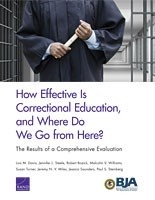| 来源类型 | Research Reports
|
| 规范类型 | 报告
|
| DOI | https://doi.org/10.7249/RR564
|
| ISBN | 9780833084934
|
| 来源ID | RR-564-BJA
|
| How Effective Is Correctional Education, and Where Do We Go from Here? The Results of a Comprehensive Evaluation |
| Lois M. Davis; Jennifer L. Steele; Robert Bozick; Malcolm V. Williams; Susan Turner; Jeremy N. V. Miles; Jessica Saunders; Paul S. Steinberg
|
| 发表日期 | 2014
|
| 出版年 | 2014
|
| 页码 | 152
|
| 语种 | 英语
|
| 结论 |
Adult Correctional Education Improves Postrelease Outcomes- Inmates who participate in correctional education programs had a 43 percent lower chance of recidivating than those who did not — a reduction in the risk of recidivating of 13 percentage points.
- Providing correctional education can be cost-effective when it comes to reducing recidivism.
- The odds of obtaining employment postrelease among inmates who participated in correctional education was 13 percent higher than for those who did not, but only one study had a high-quality research design.
Several Programs for Incarcerated Juveniles Show Promise- Two juvenile correctional education programs show promise: Read 180 and Florida's Avon Park Youth Academy.
- The field is ripe for conducting larger-scale randomized trials.
Key Trends in the Current Correctional Education Landscape- The 2008 recession led to an overall 6 percent decrease in states' correctional education budgets between fiscal years 2009 and 2012, but it had a much larger impact on states with large and medium prison populations (a 20 and 10 percent decrease, respectively).
- Most states reported using computers in correctional education, but student access to the Internet or Internet-based instruction was limited in most states.
- Of the states planning to implement the more rigorous 2014 General Education Development (GED) exam that relies on computer-based testing, there are concerns about teachers being adequately prepared to teach it and about the time it may take to prepare students for it, as well as about the negative effect on GED completion rates. Medium and large states are expected to encounter more challenges.
|
| 摘要 |
- Research needs to get inside the "black box" of what does and does not work in correctional education programs to help policymakers make programmatic tradeoffs in a resource-constrained environment.
- Doing so requires (1) further developing the evidence base by leveraging grant mechanisms to encourage more rigorous research designs, measure intervention details like program dosage, and assess different educational instructional models, innovative strategies to implement information technology in the classroom and enhance instruction, and instructional quality in correctional education settings; (2) establishing a study registry to collect the information from such research; and (3) for the very nascent field of correctional education for incarcerated juveniles, developing large-scale randomized trials and rigorous natural experiments, encouraging partnerships between educators, correctional systems, and researchers, and ensuring the data on juveniles is being collected at the federal level.
- Two trends merit policy attention. First, given the growing role of information technology in society, policymakers need to determine how to effectively leverage such technology for correctional education and assess its impact on instruction and outcomes. Second, the 2014 GED and the use of computer-based testing have raised serious concerns; policymakers should consider opportunities for technical assistance to educators to implement the more rigorous exam and computer-based testing. Beyond that, policymakers must assess and monitor the impact of the 2014 GED exam on students' preparedness and completion rates and on recidivism and employment outcomes.
|
| 主题 | Educational Program Evaluation
; Educational Technology
; Incarceration
; Juvenile Delinquency
; Prisoner Reentry
; Recidivism
; United States
|
| URL | https://www.rand.org/pubs/research_reports/RR564.html
|
| 来源智库 | RAND Corporation (United States)
|
| 引用统计 |
|
| 资源类型 | 智库出版物
|
| 条目标识符 | http://119.78.100.153/handle/2XGU8XDN/107872
|
推荐引用方式
GB/T 7714 |
Lois M. Davis,Jennifer L. Steele,Robert Bozick,et al. How Effective Is Correctional Education, and Where Do We Go from Here? The Results of a Comprehensive Evaluation. 2014.
|
|
文件名:
|
x1530644887723.jpg
|
|
格式:
|
JPEG
|

|
文件名:
|
RAND_RR564.pdf
|
|
格式:
|
Adobe PDF
|
除非特别说明,本系统中所有内容都受版权保护,并保留所有权利。